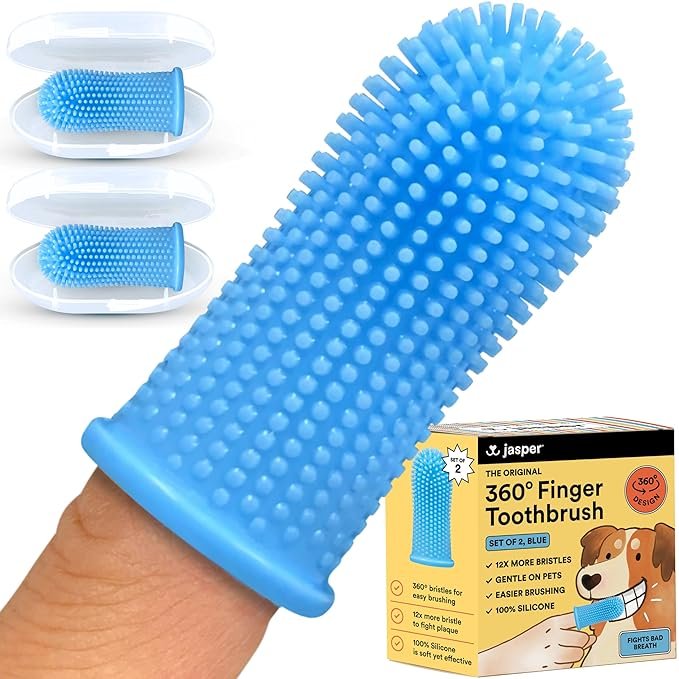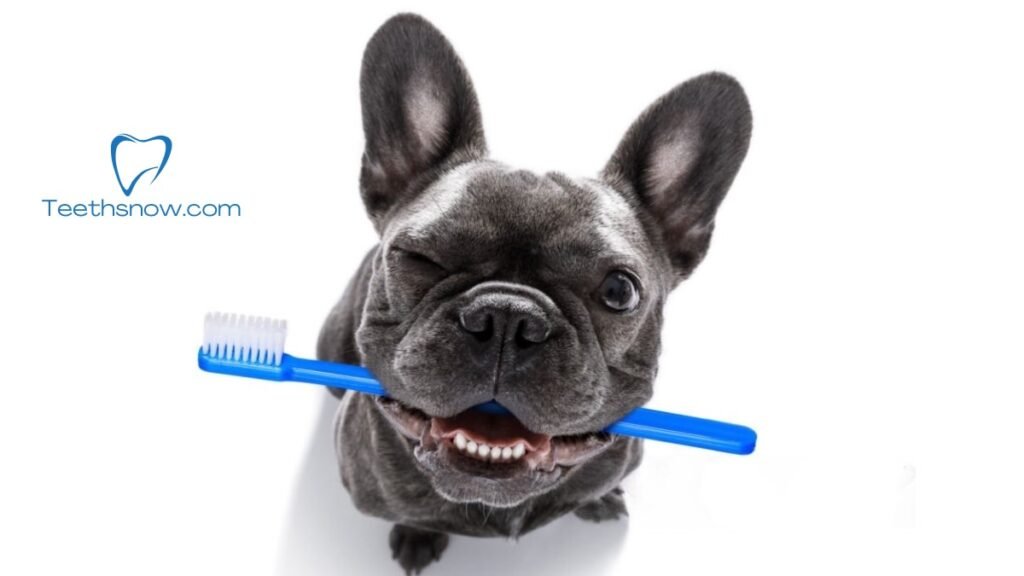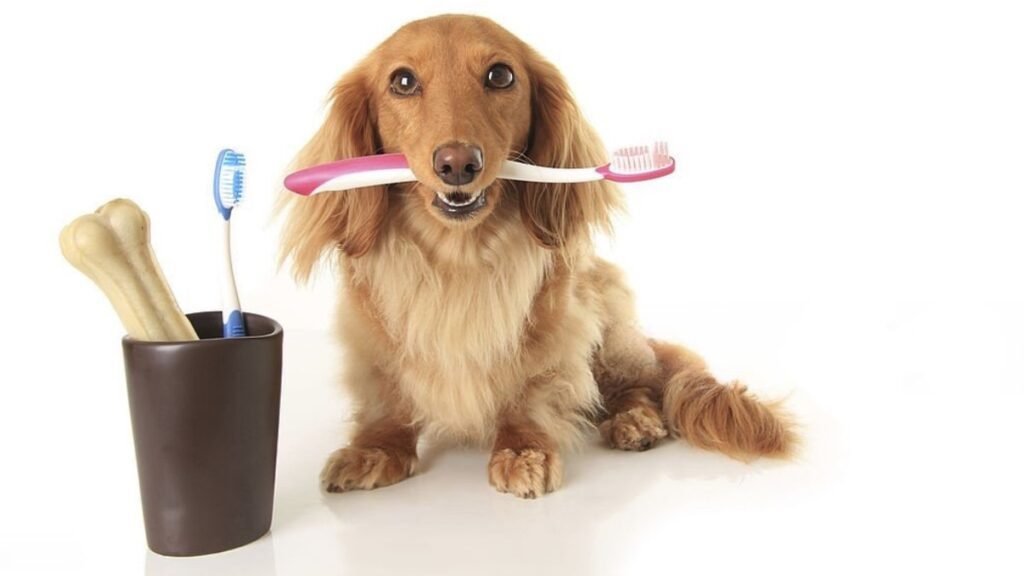Your dog’s loving nuzzle and wagging tail are blessings we cherish daily. But have you ever had a whiff of bad breath when leaning in for a kiss? It’s not just off-putting—it’s a warning. This tells us that pet oral care is vital, not only for our comfort but for our pet’s health.
Choosing an effective dog toothbrush goes beyond fresh breath. It’s about enhancing the lives and dental health of dogs, who bring us endless happiness.
- Understanding the Importance of Dental Health in Dogs
- Identifying the Signs of Dental Issues in Your Dog
- Types of Dog Toothbrushes: Pros and Cons
- Features to Look for in the Best Dog Toothbrush
- Top Dog Toothbrushes and Toothpaste: A Comparative Review
- How to Introduce Your Dog to Tooth Brushing: Tips and Tricks
- Innovative dog dental care products and accessories
Understanding the Importance of Dental Health in Dogs
Talking about canine dental care means more than just a great smile for your dog. It’s key to stopping dental issues early, just like with people. Good teeth and gum health are vital for your dog’s overall happiness.
Some dog owners don’t realize how crucial the vet’s recommended oral hygiene is. Adding these practices to your pet’s daily life helps fight tartar, gingivitis, and more. Without proper dental care, dogs can suffer from more than just bad breath. It could lead to pain, tooth loss, or other big health problems.
- Brushing your dog’s teeth often with the right products helps prevent tooth decay and disease.
- Providing dental-friendly diets and chew toys helps fight plaque.
- Just like for us, professional dental cleanings by a vet help prevent dog dental diseases.
Making canine dental care a part of your daily routine with your pet avoids future issues and stress. It’s not just about upkeep; it’s about making your dog’s life better. By sticking to vet-recommended oral hygiene, your dog stays joyful, healthy, and proud to show off their shiny teeth.
Identifying the Signs of Dental Issues in Your Dog
As a caring dog owner, watching for signs of gum disease in dogs is key. Spotting these symptoms early can prevent more severe health issues. This helps keep your dog happy and pain-free. Look out for changes in behavior or how they eat, as this can point to mouth discomfort. Let’s see how you can spot oral hygiene issues in your furry friend.
Common Symptoms of Oral Hygiene Neglect
Keep an eye out for clues of dental problems, like ongoing bad breath. It’s not just “dog breath,” it might show more serious concerns. Also, be aware of tooth decay or tartar. If your dog avoids hard foods or stares at their mouth, it’s time to check their teeth closer. Receding gums or loose teeth are serious signals to act quickly.
When to Consult a Veterinarian About Your Dog’s Dental Health
Do not delay veterinary help until your dog seems really in pain. Getting regular dental checks for pets helps prevent bigger issues. If you see swelling, pain, or bleeding gums, call your vet. Getting professional cleanings and checks is vital for your dog’s dental health. It prevents bigger, more expensive problems later on.
Types of Dog Toothbrushes: Pros and Cons
Picking the right toothbrush for your dog is very important for their health. There are different toothbrushes you can choose from. Each has its own pros and cons. Knowing about these will help you find the best dental care products for pets.
- Manual dog toothbrushes: These are similar to human toothbrushes and let you control the brushing. They are good for pets that need gentle care. But they might not get all the hard-to-reach spots in your dog’s mouth.
- Finger Toothbrushes: You wear these on your fingertip, which makes it easier to clean difficult areas. However, there’s a chance your pet might bite you. They also might not clean as well as other brushes.
- Electric Dog Toothbrushes: These brushes clean very well with less effort from you. They use moving bristles to fight plaque and keep gums healthy. Some pets might be scared of the noise and feel it at first, though.
When choosing, think about your dog’s size, how they behave, and their dental health. What’s good for one dog may not work for another. It’s crucial to weigh the advantages against the disadvantages for your pet’s specific needs.
| Toothbrush Type | Pros | Cons |
|---|---|---|
| Manual | Full brushing control is affordable and offers different designs. | More effort is needed; it might not clean everywhere. |
| Finger | Better reach, gives you a feel for the brushing, and is less scary for pets. | The risk of being bitten may not fit all dogs. |
| Electric | Thorough cleaning, easier to use, great for plaque | It needs time to get used to and often costs more. |
Choosing the right toothbrush is key to your dog’s health. Look at each toothbrush’s good and bad sides to decide wisely. Regular brushing with the best dental care practices will keep your dog’s teeth healthy and strong.
Features to Look for in the Best Dog Toothbrush
Finding the right, effective pet dental care tools is crucial. The journey to pick a dog toothbrush focuses on both cleanliness and comfort. Let’s talk about what your dog’s toothbrush should have.

Dog Toothbrush, 360º Dog Tooth Brushing Kit, Cat Toothbrush, Dog Teeth Cleaning, Dog Finger Toothbrush, Dog Tooth Brush for Small & Large Pets
SAFE & EFFECTIVE – 100% Silicone is BPA and Phthalate-free.
Ergonomic Design for Easy Handling
It’s important to have an ergonomic design for the toothbrush. This causes less stress on your hands, making the cleaning fun for you and your dog. A good handle helps you clean thoroughly, turning a tough job into an easy one.
Bristle type and strength
Bristles are key to effective pet dental care. They need to be tough on plaque but gentle on gums. Go for soft to medium bristles. They clean deeply without hurting your dog’s mouth.
Size and Fit for Your Dog’s Mouth
The toothbrush’s size should match your dog’s mouth. It’s too big, and it’s hard to use. It’s too small, and it won’t clean well. When selecting a dog toothbrush, you’ll find sizes for all dogs. This ensures a comfortable toothbrush for dogs of all sizes.
Top Dog Toothbrushes and Toothpaste: A Comparative Review
Choosing the right dog toothbrush and toothpaste is crucial for your dog’s dental health. Many products are available, from well-liked pet toothbrush brands to innovative dental solutions. We’ll compare manual and electric options to assist you in finding the best fit for your pet.

Manual Dog Toothbrushes That Pet Owners Love
Some pet owners prefer manual toothbrushes for their simplicity and control. Manual brushes are softer on dogs who dislike vibration, making them a popular choice. Here’s a list of trusted brands:
- Petrodex Enzymatic Toothbrush for Dogs: ergonomic handle for easy grip
- Arm & Hammer Clinical Care: Dual-ended design to suit varying mouth sizes
- Virbac C.E.T. Oral Hygiene Kit: Soft bristles and a special angled head
Electric Toothbrush Options for Dogs
Electric toothbrushes for pets are becoming more popular. These brushes promise a thorough clean with minimal effort. Here’s a look at some of the of the top electric toothbrush choices for dogs:
| Brand | Bristle Type | Speed Settings | Special Features |
|---|---|---|---|
| Brite Bite | Soft Silicone | Single | Self-brushing design |
| Orapup Brush | Ultra-soft nylon | Variable | Lickable brush for easy use |
| Emmi-pet | Soft Nylon | Ultrasonic | Noiseless operation |
Dog-Friendly Toothpaste Choices
Choosing the right toothpaste is as important as finding the perfect toothbrush. Dog toothpaste is safe to swallow and comes in flavors dogs enjoy. Here are some great toothpaste choices for both manual and electric brushes:
- Petrodex Enzymatic Toothpaste is a pudding-flavored, non-foaming formula.
- Virbac C.E.T. Enzymatic Toothpaste, beef-flavored, helps reduce plaque.
- TropiClean Fresh Breath Dental Health Solution is a water additive for easy dental care.
Picking the right dental products—whether manual or electric—can make cleaning your dog’s teeth enjoyable. The best choice depends on your dog’s size, likes, and comfort. Staying committed to their dental health leads to a happy, healthy-smiled pet.
How to Introduce Your Dog to Tooth Brushing: Tips and Tricks
Teaching your dog to brush their teeth can be tough, but it’s very important. Here are some tips to make brushing your dog’s teeth easy and fun for both of you. This will ensure your dog’s dental care routine is top-notch.
- Start with short sessions and reward your dog to make tooth-brushing fun for dogs.
- Use a toothbrush and toothpaste specially made for dogs. Their size and flavor really help.
- Before you use a toothbrush, touch your dog’s teeth and gums with your finger. This gets them used to the feeling.
- Let your dog taste the toothpaste before starting to brush gently. Focus on areas where plaque builds up.
- Brush with care, focusing on the plaque-prone areas and being mindful of your dog’s comfort level.
- Show your dog love and praise after brushing. This makes tooth brushing a positive experience.
To prevent health problems, it’s vital to brush your dog’s teeth regularly. Using these tips, you can gently introduce your dog to brushing. Remember, patience and consistency are key. Soon, your dog may even start to enjoy brushing.
| Step | Description | Tips for success |
|---|---|---|
| 1 | Choose the right time. | Choose a calm time for your dog, like after a walk or playtime. |
| 2 | Familiarize yourself with tools | Let your dog get used to the toothbrush and toothpaste by sniffing and licking them. |
| 3 | Initial gum contact | Start by gently rubbing your finger along your dog’s gums and teeth. This helps them get used to brushing. |
| 4 | First brushing | Put a little toothpaste on the brush and softly brush a couple of teeth to start. |
| 5 | Build-up duration | Slowly brush more teeth each time, aiming for a full session over a few weeks. |
| 6 | Reward and praise | Always end brushing sessions with a treat to make it a positive experience. |
The Dog Toothbrush
Maintaining your furry friend’s dental hygiene is vital. Not every toothbrush is right for them. It’s important to know what specific needs your dog’s teeth have. A specialized dog toothbrush plays a key role in boosting their dental health. Choosing the right toothbrush can greatly improve your dog’s oral care.
Understanding the Specifics of a Dog Toothbrush
What makes a dog toothbrush special? These brushes are made to fit a dog’s mouth perfectly. They have unique designs with various angles and bristle configurations. This helps clean those hard-to-reach spots where plaque and tartar like to hide. Using a toothbrush made for dogs means you can clean their teeth much better than a regular human toothbrush can.
Why the Correct Dog Toothbrush Makes a Difference
The need for a dog-specific toothbrush is huge. A proper brush means better plaque removal and healthier gums for your dog. It matches the shape and size of your dog’s teeth and mouth. Plus, it’s often more comfy for them, making brushing more enjoyable. This can make them less likely to fight the routine. Thus, it enhances canine dental health over time.
Innovative dog dental care products and accessories
If you love your pet, you’re always searching for new pet care innovations. The pet oral care sector has seen a lot of new dog dental products. These aren’t just extra items; they’re key to keeping your dog’s teeth clean. This is vital for pets who don’t like using a normal toothbrush.
Dental Chew Toys That Help Clean Teeth
Dog dental chews are a smart and tasty way to keep your dog’s teeth clean. These chews come in different materials, like rubber and special edible substances. They help reduce plaque and tartar by encouraging your dog to chew. Many also have ingredients to freshen breath and boost gum health. They’re a must-have for your dog’s dental care.
Water Additives and Dental Sprays for Oral Health
For a simple dental care option, try water additives for dogs. You can add these to your dog’s water. They help stop plaque, freshen breath, and prevent gum disease easily. Also, dental sprays for dogs provide a quick way to apply health-boosting substances to your dog’s mouth. These sprays can fight bacteria and keep the mouth healthy. They’re great for dogs who don’t like brushing.
FAQ
What types of dog toothbrushes are available?
There’s a variety to choose from. You can find manual, electric, and finger toothbrushes. Each kind suits different needs based on your dog’s size and behavior. Think about what you prefer, too.
How often should I brush my dog’s teeth?
Vets say to brush daily to stop plaque and tartar. This helps prevent tooth problems. But brushing a few times a week is also good if you can’t do it every day.
What are some signs that my dog has dental issues?
Watch out for bad breath and sore or bleeding gums. Trouble eating and missing teeth are red flags too. If you see these, a vet visit is crucial.
What features should I look for in the best dog toothbrush?
Look for a toothbrush that’s easy to hold and has the right bristle strength. It shouldn’t hurt the gums, but it should still clean well. Also, make sure it fits in your dog’s mouth.
Can I use human toothpaste on my dog?
No, it’s risky because of the xylitol and fluoride in our toothpaste. Always choose toothpaste made for dogs. It’s safer, and they’ll like the taste.
How do I introduce my dog to tooth brushing?
Begin with toothpaste tastings and gum massages. Then, slowly, use the toothbrush. Always praise and treat them for cooperating. Keep it short and fun, and increase brushing time as they get used to it.
Are dental chew toys effective for cleaning my dog’s teeth?
Yes, they help by scraping off plaque as your dog chews. Yet, they work best with brushing for top oral care.
What is the importance of using a specialized dog toothbrush?
These toothbrushes fit your dog’s mouth better. They have angled handles and bristles for effective cleaning. Generally, they do a better job than DIY options.
Should I consider electric toothbrushes for my dog?
If your dog is okay with the noise and feel, they’re a great choice. They clean well with less effort. Just ensure it’s dog-friendly for safety.
How do water additives and dental sprays contribute to my dog’s oral health?
They tackle bacteria, cut down on plaque, and freshen breath. They’re great alongside brushing, especially for brush-hating dogs.









1 Comment
Pingback: Dog Dental Cleaning Cost: What to Expect